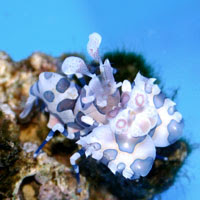Octopuses have much going for and against them as pets. They are, without a doubt, the most intelligent of the invertebrates, and often seem to rival much more “advanced” creatures in brain power. Able to distinguish and associate various shapes with a food reward, some have even learned to unscrew glass jars to obtain food. In one laboratory, cameras revealed that an octopus was leaving its aquarium each night to prey upon crabs held in a neighboring tank. Each morning, the octopus was found back in his own aquarium, having crossed several feet of dry shelf space in his nocturnal travels! One that I kept would, according to my grandmother, “watch her” as she prepared dinner (octopus see very well, and notice movement outside their aquariums). Unnerved by the thought of our pet witnessing the demise of his relatives, she would cover the aquarium with a towel on those days when she cooked octopus or squid for dinner!
 On the down side, however, all species studied are quite short-lived (2 years at most) – quite odd considering their complex lifestyles. Males generally expire right after mating, and females survive only long enough to see their eggs through hatching.
On the down side, however, all species studied are quite short-lived (2 years at most) – quite odd considering their complex lifestyles. Males generally expire right after mating, and females survive only long enough to see their eggs through hatching.
The species most often seen in the pet trade is the common tropical octopus, Octopus cyaneus (please note that there is a good deal of confusion as to the identification of this species). Growing to a maximum length of 12 inches, it does well if provided excellent water quality (manage it as you would a delicate reef fish) and a secure retreat in which to hide. Octopuses absolutely need to hide and are intolerant of disturbance (although once acclimated many will become quite bold at feeding time). It is also important to avoid suddenly putting on a light if the room in which the aquarium sits is dark. When disturbed, octopuses release a dark-colored ink (sepia), which can be toxic to the animal in close quarters.
Bear in mind that octopuses consume large amounts of food and produce copious waste products – good filtration, frequent water quality tests and water changes are vital if you are to keep them successfully. Give your octopus the largest aquarium possible (this will help with water quality and in reducing stress on the animal) and be sure the lid is weighed down or otherwise fastened. The common tropical octopus does well at temperatures of 76-78 F. As most species are nocturnal, you should equip the aquarium with a bulb designed for nighttime viewing so as to be able to observe your pet without disturbing it.
Most octopus favor crabs, shrimp, clams, scallops, mussels and other shellfish, but usually take fish as well. Seafood markets are useful sources of food for your pet – as we know little of their nutritional requirements, I suggest providing as much dietary variety as possible. The wide range of frozen marine foods now available will provide you with a great many options as well.
Other species sometimes offered for sale include the red or pygmy octopus, O. bocki, which is highly nocturnal, and the common octopus, O. vulgaris. As the common octopus occupies a range spanning the Mediterranean, the Sea of Jap an and the Eastern Atlantic, it is likely a fairly hardy creature. However, with a leg-span approaching 3 feet, it is too large for most home aquariums.
an and the Eastern Atlantic, it is likely a fairly hardy creature. However, with a leg-span approaching 3 feet, it is too large for most home aquariums.
It is important to remember that all octopuses, even very small ones, can inflict painful bites with their sharp, parrot-like beaks, and that they can never be considered “tame” enough to handle. Most if not all produce venom in order to subdue their prey, and even venoms not shown to be dangerous to people can cause severe or even fatal reactions in particularly sensitive individuals. Amazingly, the tiny the blue-ringed octopus, Hapalochlaena maculosa, quite capable of killing a human with one bite, is sometimes offered for sale. Learn to recognize this species and avoid it at all costs.
Breeding octopuses in captivity is difficult, as is raising the young. Recent research at the Spanish Institute of Oceanography indicated that dietary factors, especially the absence of fatty acids such as DHA and EPA, are responsible for high mortalities among those that do hatch in aquariums. Enriched brine shrimp have been used with some success, but more variety is likely needed. I would experiment with various species of marine shrimp, worms, plankton and tiny marine creatures seined from eel grass beds and other marine habitats (check the legality of collecting before doing so).
Octopus husbandry is in need of much attention by serious hobbyists. These fascinating, complex creatures are impacted by habitat loss and collection for the food, bait and pet trade. Breeding them in captivity will certainly take pressure off wild populations and help in understanding what they need to survive in the wild.
Please write in with your own thoughts and questions. Thanks…until next time, Frank.
You can see photos of hatchling octopuses and read about a captive breeding effort at:http://www.bbc.co.uk/norfolk/your/a-z_norfolk/a-z_octopus.shtml
 That Fish Blog – Aquarium Advice and Information
That Fish Blog – Aquarium Advice and Information



